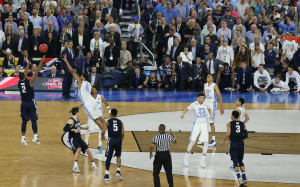
By PAUL GOTHAM
HOUSTON, TX. — Jay Wright didn’t sprinkle pixie dust, nor did the Villanova coach wave a magic wand. Instead Wright’s Wildcats took the ordinary and turned it into the first buzzer-beat to win the national championship since 1983.
“We have certain plays with less than four seconds, from four to seven seconds,” Wright explained. “Every coach has this. Zero to four, four to seven, seven to 12. We have plays. So we know what it is. We practice it every day.”
In the final count, Ryan Arcidiacono used six dribbles to cover 54 feet, shovel a pass to Kris Jenkins for a catch and release. All in 4.7 seconds. Considering Arcidiacono didn’t go in a straight line (he used a cross over dribble to set a Daniel Ochefu ball screen), one realizes how much can be done in how little time.
“It’s what we do every single day in practice,” Arcidiacono said. “Daniel set the screen for me because they let the ball come in. I was going to be aggressive off the screen. Kris did a great job of sprinting into the play. Once I heard him, I just flipped it to him.”
Jenkins inbounded the ball and got it back 69 feet later. Proving again the inbounder can be the most dangerous player on the floor, but usually that applies in the half-court. Jenkins made it happen in the full court.
Sidebar: Christian Laettner‘s first buzzer-beater in the 1990 East Regional final was a sideline inbound where the then-sophomore passed to teammate Brian Davis, took two or three steps on to the court, received the ball back, stepped in and hit a jumper from just outside the lane. That play happened in 2.6 seconds. The following season, every high school coach in the country included that play in their sideline out-of-bounds package.
Monday, Jenkins fed Arcidiacono and ran the floor to seal Villanova’s 77-74 victory over the University of North Carolina Tar Heels. He ran the floor virtually uncovered. Maybe the Tar Heels were distracted by Ochefu who grabbed a mop to make sure the floor was dry where he would set a screen.
“From previous games I realize when I take the ball out, the ball gets up the court, the defenders usually follow the ball,” Jenkins said. “I knew when I gave “Arch” the ball, he was going to be aggressive. They were going to try to take “Arch” away because he’s hit big shots in his career. When they all followed the ball, I just knew if I got in his line of vision, he would find me.”
UNBELIEVABLE!!!!!! #NationalChampionship https://t.co/POLVkUJnpj
— NCAA March Madness (@marchmadness) April 5, 2016
That’s what can happen when two seniors (Arcidiacono and Ochefu) combine with a junior (Jenkins). What shouldn’t be lost in the mix were the roles played by Josh Hart, a junior, and Phil Booth, a sophomore. The pair stayed out of the way and gave their teammates space to work.
“I didn’t have to say anything in the huddle,” Wright said. “We have a name for it, that’s what we’re going to do. Just put everybody in their spots.”
Experience played a big part in that 4.7 seconds.
“Kris Jenkins’s explanation was brilliant,” Wright continued. “That’s what I said to him when he was walking out (of the huddle). Because he’s the last option because he’s the inbounder. If he can catch up with “Arch” and get ahead of him and get in his vision, that’s your last look. But the first look is “Arch,” then Josh Hart is screening for Phil Booth. He’s last look. For him to realize that the inbounder wasn’t staying with him, he’s one of the smartest basketball players we’ve ever had.”

Leave a Reply